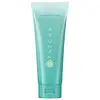What's inside
What's inside
 Key Ingredients
Key Ingredients

 Benefits
Benefits

 Concerns
Concerns

 Ingredients Side-by-side
Ingredients Side-by-side

Water
Skin ConditioningCocamidopropyl Hydroxysultaine
CleansingCoco-Betaine
CleansingSodium Lauroyl Oat Amino Acids
CleansingDecyl Glucoside
CleansingSodium Cocoyl Sarcosinate
CleansingAcrylates Copolymer
Copernicia Cerifera Wax
Jojoba Esters
EmollientSodium Chloride
MaskingPolysorbate 20
EmulsifyingDisodium Cocoyl Glutamate
CleansingCitrus Limon Peel Oil
MaskingCitrus Grandis Peel Oil
MaskingMentha Viridis Leaf Oil
AstringentPanax Ginseng Root Extract
EmollientCaffeine
Skin ConditioningGarcinia Mangostana Peel Extract
Skin ConditioningCordyceps Sinensis Extract
AntioxidantButylene Glycol
HumectantEthylhexylglycerin
Skin ConditioningGlycerin
HumectantAloe Barbadensis Leaf Juice
Skin ConditioningSodium Cocoyl Glutamate
CleansingMonosodium Citrate
BufferingCitric Acid
BufferingSodium Hydroxide
BufferingDisodium EDTA
Methylchloroisothiazolinone
PreservativeMethylisothiazolinone
PreservativePhenoxyethanol
PreservativeAquilaria Agallocha Wood Oil
MaskingWater, Cocamidopropyl Hydroxysultaine, Coco-Betaine, Sodium Lauroyl Oat Amino Acids, Decyl Glucoside, Sodium Cocoyl Sarcosinate, Acrylates Copolymer, Copernicia Cerifera Wax, Jojoba Esters, Sodium Chloride, Polysorbate 20, Disodium Cocoyl Glutamate, Citrus Limon Peel Oil, Citrus Grandis Peel Oil, Mentha Viridis Leaf Oil, Panax Ginseng Root Extract, Caffeine, Garcinia Mangostana Peel Extract, Cordyceps Sinensis Extract, Butylene Glycol, Ethylhexylglycerin, Glycerin, Aloe Barbadensis Leaf Juice, Sodium Cocoyl Glutamate, Monosodium Citrate, Citric Acid, Sodium Hydroxide, Disodium EDTA, Methylchloroisothiazolinone, Methylisothiazolinone, Phenoxyethanol, Aquilaria Agallocha Wood Oil
Water
Skin ConditioningSodium Cocoyl Glutamate
CleansingPropanediol
SolventGlycerin
HumectantAcrylates Copolymer
Coco-Betaine
CleansingCamellia Sinensis Leaf
PerfumingLuffa Cylindrica Fruit/Leaf/Stem Extract
Skin ConditioningLuffa Cylindrica Fruit
AbrasiveSodium Lauroyl Hydrolyzed Silk
Skin ConditioningRosa Multiflora Fruit Extract
MaskingBelamcanda Chinensis Root Extract
Skin ConditioningPotassium Hydroxide
BufferingSodium Chloride
MaskingPolyglyceryl-10 Dioleate
EmulsifyingPolyglyceryl-2 Sesquicaprylate
EmulsifyingButylene Glycol
HumectantEthylhexylglycerin
Skin ConditioningTetrasodium EDTA
Parfum
MaskingAlcohol
AntimicrobialPhenoxyethanol
PreservativeWater, Sodium Cocoyl Glutamate, Propanediol, Glycerin, Acrylates Copolymer, Coco-Betaine, Camellia Sinensis Leaf, Luffa Cylindrica Fruit/Leaf/Stem Extract, Luffa Cylindrica Fruit, Sodium Lauroyl Hydrolyzed Silk, Rosa Multiflora Fruit Extract, Belamcanda Chinensis Root Extract, Potassium Hydroxide, Sodium Chloride, Polyglyceryl-10 Dioleate, Polyglyceryl-2 Sesquicaprylate, Butylene Glycol, Ethylhexylglycerin, Tetrasodium EDTA, Parfum, Alcohol, Phenoxyethanol
 Reviews
Reviews

Ingredients Explained
These ingredients are found in both products.
Ingredients higher up in an ingredient list are typically present in a larger amount.
Acrylates Copolymer is used as a film-forming agent and texture enhancer.
After applied, Acrylates Copolymer forms a thin film cover that helps skin feel more soft. It can help sunscreens become more water-resistant.
It is also used to make a product more thick.
Learn more about Acrylates CopolymerButylene Glycol (or BG) is used within cosmetic products for a few different reasons:
Overall, Butylene Glycol is a safe and well-rounded ingredient that works well with other ingredients.
Though this ingredient works well with most skin types, some people with sensitive skin may experience a reaction such as allergic rashes, closed comedones, or itchiness.
Learn more about Butylene GlycolCoco-Betaine is the natural version of Cocamidopropyl Betaine. It is often derived from coconuts.
Coco-Betaine is a surfactant, meaning it helps remove dirt and oil from the skin.
Ethylhexylglycerin (we can't pronounce this either) is commonly used as a preservative and skin softener. It is derived from glyceryl.
You might see Ethylhexylglycerin often paired with other preservatives such as phenoxyethanol. Ethylhexylglycerin has been found to increase the effectiveness of these other preservatives.
Glycerin is already naturally found in your skin. It helps moisturize and protect your skin.
A study from 2016 found glycerin to be more effective as a humectant than AHAs and hyaluronic acid.
As a humectant, it helps the skin stay hydrated by pulling moisture to your skin. The low molecular weight of glycerin allows it to pull moisture into the deeper layers of your skin.
Hydrated skin improves your skin barrier; Your skin barrier helps protect against irritants and bacteria.
Glycerin has also been found to have antimicrobial and antiviral properties. Due to these properties, glycerin is often used in wound and burn treatments.
In cosmetics, glycerin is usually derived from plants such as soybean or palm. However, it can also be sourced from animals, such as tallow or animal fat.
This ingredient is organic, colorless, odorless, and non-toxic.
Glycerin is the name for this ingredient in American English. British English uses Glycerol/Glycerine.
Learn more about GlycerinPhenoxyethanol is a preservative that has germicide, antimicrobial, and aromatic properties. Studies show that phenoxyethanol can prevent microbial growth. By itself, it has a scent that is similar to that of a rose.
It's often used in formulations along with Caprylyl Glycol to preserve the shelf life of products.
Chances are, you eat sodium chloride every day. Sodium Chloride is also known as table salt.
This ingredient has many purposes in skincare: thickener, emulsifier, and exfoliator.
You'll most likely find this ingredient in cleansers where it is used to create a gel-like texture. As an emulsifier, it also prevents ingredients from separating.
There is much debate on whether this ingredient is comedogenic. The short answer - comedogenic ratings don't tell the whole story. Learn more about comegodenic ratings here.
The concensus about this ingredient causing acne seems to be divided. Research is needed to understand if this ingredient does cause acne.
Scrubs may use salt as the primary exfoliating ingredient.
Learn more about Sodium ChlorideSodium Cocoyl Glutamate is a gentle cleanser and surfactant. It is the sodium salt of the Cocoyl Glutamic Acid and comes from coconut oil. As a surfactant, it helps lift dirt and oil to be washed away.
Sodium Cocoyl Glutamate also has an emolliating effect and can help leave the skin feeling soft.
Water. It's the most common cosmetic ingredient of all. You'll usually see it at the top of ingredient lists, meaning that it makes up the largest part of the product.
So why is it so popular? Water most often acts as a solvent - this means that it helps dissolve other ingredients into the formulation.
You'll also recognize water as that liquid we all need to stay alive. If you see this, drink a glass of water. Stay hydrated!
Learn more about Water